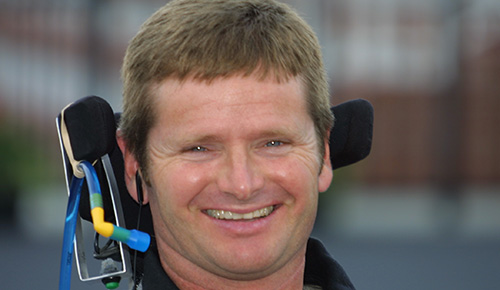CP MOTORSPORTS - INTUITIVE SCHMIDT SEES MORE WORK FOR HIS MISSION

James Hinchcliffe’s brutal accident at the Indianapolis Motor Speedway this past Monday weighed heavily on team co-owner Sam Schmidt’s mind.
Once he knew Hinchcliffe was receiving excellent medical care and knew the cause of the incident that happened during post-qualifying practice for the Indianapolis 500, Schmidt shared the information with the other teams. He hurriedly secured Ryan Briscoe to drive the Arrow-Lucas Oil Honda in the 99th running of the Memorial Day classic. And he buoyed his crew’s spirits, for he knew they needed it after not only the crash but what he described as 250-300 hours of prep work for the world’s most celebrated auto race.
“We spent a lot of the first 24 hours reviewing to make sure that we had covered all our bases properly and that the rest of the paddock had whatever knowledge they needed for proper race changes,” Schmidt said. “First and foremost, I was really concerned that we had missed something or we’d made a mistake in preparation.”
He’s breathing easier, knowing that “we didn’t do anything wrong” and that Hinchcliffe astoundingly has been mobile at IU Health Methodist Hospital. The popular driver took short walks Friday and wisecracked about “knocking out 5Ks in no time.”
But lurking in Schmidt’s mind is the truth that this wreck could have had a grimmer outcome. He said a “perfect storm” of circumstances triggered it. But he also knew a perfect rainbow of quick and wise decisions by superbly trained IndyCar safety personnel and doctors and nurses at Methodist saved Hinchcliffe’s life. The driver used social media to call those individuals his heroes.
Schmidt knows those heroes don’t always win their most difficult battles. They couldn’t in the 2011 case of his driver Dan Wheldon, a two-time Indianapolis 500 winner.
But Schmidt already knew that firsthand. He has used a wheelchair for 15 years, ever since his own January 2000 crash at Orlando that left him a quadriplegic from a C-3/4/5 spinal-cord injury. But that wicked twist of life also gave him a mission, one he said made him “come to the realization that I'm helping a lot more people now that I ever could as a driver.”
Seeing the proactive Eric Medlen Project, which offered solutions in a calamitous 2007 NHRA drag-racing season at John Force Racing, Schmidt was inspired.
“You’ve seen, unfortunately, reactive measures instead of progressive. But after John Force’s deal and [Eric] Medlen’s, [you saw] massive, massive changes to the cockpits of those cars. And it has been self-driven,” he said.
Competition Plus suggested a “summit meeting” of safety leaders from the NHRA, IndyCar Series, and NASCAR to brainstorm about common concerns.
And Schmidt said, “That sounds like a fantastic idea. We’ve got a lot of people based here [in the Indianapolis area]. I think there are some subcontractors [safety-equipment manufacturers or vendors] here. So there has been a sort of cross-reference with information – but not a formal, three- or four-day think tank to improve the safety of the industry as a total. And that’s not a bad idea.”
Referring to the NHRA’s nitro contingent, Schmidt said, “They’re going 300 miles an hour. We’re going 240 miles an hour. They don’t necessarily have SAFER barriers on those dragstrips like we do [in the Verizon IndyCar Series]. Maybe they should.”
He said, “We’re all vehemently concerned about the fans, making sure none of them receives any injuries, and about the drivers and cars. If just one change happened to save one life and/or save a life-threatening injury like this [Hinchcliffe’s], it’d be worth it.”
As for his own team’s concerns, Schmidt said, “The reality is that our procedures are no different than Penske’s or Ganassi’s or Andretti’s or any of those guys’ – and we need to change them probably, even though nobody has had a failure like this [Hinchcliffe’s broken rocker] in 15 years of running this style of car. Nobody probably would again. But here we are. We’ve just got to adapt and cover all the bases.”
The severity of Hinchcliffe’s accident resonated around the globe, for Schmidt said he has received encouraging messages “from all over the world.”
And he said he expected it to resonate with the sanctioning body throughout the next few months: “There’ll certainly be a lot of conversation before we come back [to Indianapolis] next year, if any changes need to be made to the cars or SAFER barriers, track, or whatever.
“I think there was a huge surge in the first 48 hours to evaluate, make sure there was nothing that needed to be done for the race,” Schmidt said. He said he expected the course of discussion would be to “take a step back, maybe re-evaluate some things over the off-season.”
Meanwhile, Schmidt already is working with a drag-racing legend, one whose career also was halted in its prime. This April marked 25 years since Gwynn’s Top Fuel accident in England cost him part of one arm and paralyzed him from the chest down.
Schmidt and Gwynn have become close friends, and their foundations cooperate to help those with spinal cord or other neurological traumas.
“When I decided to start my race team in 2001, I spent about five hours on the phone with Darrell, talking about travel and wheelchairs and motorhomes and everything, because he had been doing it quite some time in a chair, going to the racetrack. So he helped me immensely fast-forward and not have to reinvent the wheel as far as my travel logistics. Ad we stayed in contact,” Schmidt said.
“Our foundation is looking for a cure for paralysis. Hi foundation is more tailored towards assisting those who have been injured [by providing] wheelchairs and other items they can’t get through insurance. So we cross-pollinate quite a bit,” he said.
“If I know somebody who needs a chair or somebody who has a chair to donate, it’s always going to him because our foundation doesn’t have that component, that element of opportunity. We work together as much as we can. I have a wheelchair in my van right now that is being donated to his foundation and is being delivered to someone in Indiana,” he said.
Schmidt called Gwynn “great guy” and laughed, saying, “He’s the smart one. He got out of racing from an ownership standpoint. He’s just lying on the beach right now. It’s a lot less stressful, I can tell you that. I should be that smart.”
Sam Schmidt is plenty smart, aside from his degree from Pepperdine University. He knows he has the potent combination of resolve and resources to improve lives.




